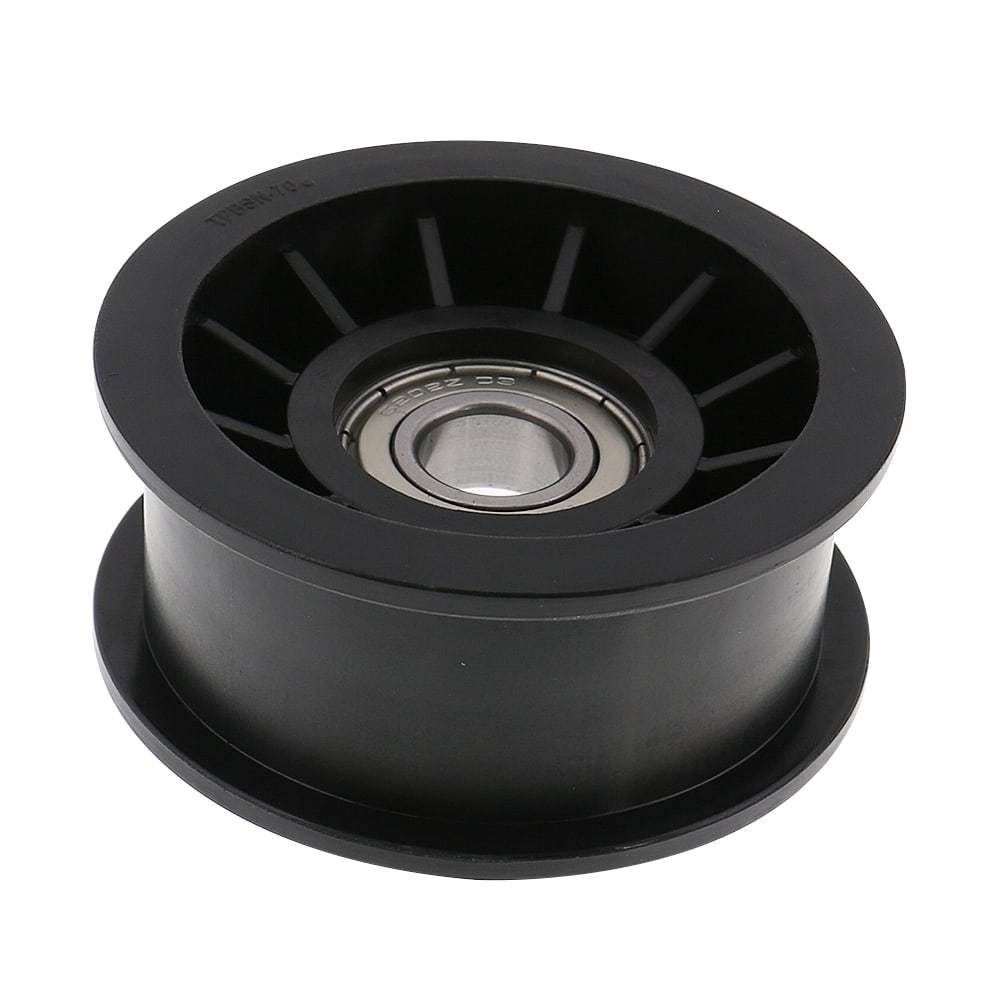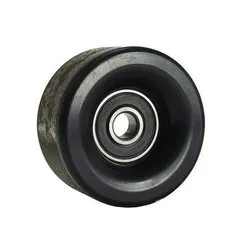Product Description
Product Description
Product Parameters
| Parameter of conveyor drum pulley | |||
| Type | Belt width | Standard diameter | Length(mm) |
| (mm) | (mm) | ||
| Length of pulley depends on the width of conveyor belt | 500 | 500 | Length of pulley
depends on the width of conveyor belt |
| 650 | 500~630 | ||
| 800 | 630~1000 | ||
| 1000 | 800~1150 | ||
| 1200 | 800~1150 | ||
| 1400 | 1000~1350 | ||
| 1600 | 1150~1600 | ||
| 1800 | 1150~1800 | ||
| 2000 | 1350~2000 | ||
| 2200 | 1600~2200 | ||
| 2400 | 1800~2400 | ||
Production Workshop
Application scenario
Our Advantages
FAQ
Q1. When can I get the price?
Usually we quote within 24 hours after we get your inquiry.
Q2: Could design and drawing the pulley for our special usage?
A: Of course, our professional engineer could design and drawing for you ASAP.
Q3:How to install the Ceramic Pulley Lagging?
A:We have experience of installation for 20 years, and could supply guidance for you by video.
Q4: How long is your delivery time?
A: Generally it is 5-10 days if the goods are in stock. or it is 15-20 days if the goods are not in stock, it is according to quantity.
Q5: Do you have foreign experience for Ceramic Pulley Lagging rubber sheet?
A: Yes, the ceramic lagging rubber sheet we manufactured have exported to Australia , South Africa , Brazil , etc.
Q6. How does your factory of regarding quality control?
A: To make sure customer buy good quality material and service from us. Before customer place order, we will send drawing to customer for approval. Before shipment, our QC staff will check quality 1pc by 1pc. Quality is our culture.
| Material: | Stainless Steel |
|---|---|
| Surface Treatment: | Baking Paint |
| Motor Type: | Frequency Control Motor |
| Samples: |
US$ 70/Piece
1 Piece(Min.Order) | Order Sample |
|---|
| Customization: |
Available
| Customized Request |
|---|
.shipping-cost-tm .tm-status-off{background: none;padding:0;color: #1470cc}
|
Shipping Cost:
Estimated freight per unit. |
about shipping cost and estimated delivery time. |
|---|
| Payment Method: |
|
|---|---|
|
Initial Payment Full Payment |
| Currency: | US$ |
|---|
| Return&refunds: | You can apply for a refund up to 30 days after receipt of the products. |
|---|
How do idler pulleys contribute to the functioning of HVAC and conveyor systems?
Idler pulleys play a crucial role in the functioning of HVAC (Heating, Ventilation, and Air Conditioning) and conveyor systems. Here’s a detailed explanation of how idler pulleys contribute to the operation of these systems:
HVAC Systems:
In HVAC systems, idler pulleys are primarily used for power transmission and belt tensioning. Here are the key ways in which idler pulleys contribute to the functioning of HVAC systems:
1. Belt Routing and Tensioning:
Idler pulleys guide and support the belts used in HVAC systems, ensuring proper routing and tensioning. They help keep the belts in alignment with the driving and driven pulleys, preventing slippage and ensuring efficient power transmission. Idler pulleys maintain the necessary tension in the belts, which is crucial for optimal HVAC system operation.
2. Load Distribution:
Idler pulleys assist in distributing the load evenly across the HVAC system. By supporting the movement of belts, they help distribute the load and minimize stress on individual components. Proper load distribution ensures balanced wear and tear, prolonging the lifespan of the system.
3. Noise and Vibration Reduction:
Idler pulleys contribute to reducing noise and vibration in HVAC systems. They help dampen vibrations caused by belt operation, resulting in quieter and smoother system performance. Reduced noise and vibration levels enhance the comfort and usability of the HVAC system.
4. System Efficiency:
Efficient idler pulley operation improves the overall efficiency of HVAC systems. Well-designed idler pulleys with low friction and proper tensioning minimize power losses, ensuring optimal energy consumption. By reducing inefficiencies and maximizing energy conservation, idler pulleys contribute to improved HVAC system performance.
Conveyor Systems:
In conveyor systems, idler pulleys are essential for belt support, tensioning, and guiding. Here’s how idler pulleys contribute to the functioning of conveyor systems:
1. Belt Support:
Idler pulleys provide support to the conveyor belt, preventing sagging and maintaining its shape. They are strategically positioned along the belt path to support the weight of the conveyed material, ensuring smooth and reliable transportation. Proper belt support is crucial for preventing belt damage and ensuring efficient material handling.
2. Tensioning:
Idler pulleys are used for belt tensioning in conveyor systems. They help maintain the appropriate tension in the conveyor belt, ensuring proper engagement with the drive pulley and preventing slippage. Proper belt tensioning is critical for efficient power transmission and preventing material spillage or jamming.
3. Belt Guiding and Tracking:
Idler pulleys guide and track the conveyor belt, ensuring it stays aligned and centered. They are designed with grooves or cylindrical surfaces that match the shape of the conveyor belt, providing guidance and preventing lateral movement. By maintaining proper belt tracking, idler pulleys minimize belt misalignment, reducing the risk of damage and improving overall conveyor system performance.
4. Load Distribution:
Idler pulleys contribute to even load distribution in conveyor systems. By supporting the belt and load, they help distribute the weight evenly across the system, minimizing stress on individual components. Proper load distribution ensures reliable and efficient operation, preventing premature wear and component failure.
5. System Reliability:
Reliable idler pulley operation is crucial for the overall reliability of conveyor systems. Idler pulleys that are correctly sized, well-maintained, and properly lubricated contribute to the smooth and continuous operation of the system. They help minimize downtime, reduce the risk of belt slippage or jamming, and ensure the efficient movement of materials.
Overall, idler pulleys are essential components for the functioning of HVAC and conveyor systems. Their role in belt routing, tensioning, load distribution, noise reduction, system efficiency, and reliability makes them integral to the smooth operation and performance of these systems.
How are idler pulleys customized for specific machinery and equipment?
Idler pulleys can be customized to meet the specific requirements of different machinery and equipment. Here’s a detailed explanation of how idler pulleys are customized for specific applications:
1. Size and Diameter:
Idler pulleys are available in a wide range of sizes and diameters. To customize an idler pulley for specific machinery and equipment, the size and diameter can be selected based on factors such as the space available, the desired belt wrap, and the required load-bearing capacity. Larger machinery may require larger idler pulleys to accommodate the size and power requirements, while smaller equipment may require compact idler pulleys to fit within limited spaces.
2. Material Selection:
The choice of material for idler pulleys depends on the specific application. Idler pulleys can be made from various materials, including steel, aluminum, plastic, or composite materials. The material selection depends on factors such as the environment, load capacity, desired weight, and durability requirements. Corrosion-resistant materials may be chosen for applications in harsh or corrosive environments, while lightweight materials may be preferred for applications where weight reduction is critical.
3. Bearing Type:
Idler pulleys utilize bearings to support the rotating shaft. The selection of bearing type depends on factors such as the load capacity, speed, and environmental conditions. Common bearing types include ball bearings, roller bearings, and needle bearings. The choice of bearing type ensures smooth rotation and proper load distribution, contributing to the overall performance and longevity of the idler pulley.
4. Mounting Configuration:
Idler pulleys can be customized with various mounting configurations to suit specific machinery and equipment. The mounting configuration includes options such as bolt-on, flange-mounted, or shaft-mounted designs. The selection depends on the installation requirements and the available mounting points on the equipment. Customizable mounting options allow for easy integration and proper alignment of the idler pulley within the system.
5. Special Features:
In some cases, idler pulleys may require special features or modifications to meet unique application needs. This can include the addition of groove profiles for specific belt types, design modifications for improved belt tracking, or the incorporation of tensioning mechanisms for precise tension adjustment. These customization options ensure that the idler pulleys are optimized for the specific machinery and equipment, resulting in enhanced performance and functionality.
6. Application-Specific Testing:
In certain cases, idler pulleys may undergo application-specific testing to validate their performance and suitability for the intended use. This can include testing for load capacity, rotational speed, temperature resistance, noise levels, and durability. By conducting these tests, manufacturers can ensure that the customized idler pulleys meet the specific requirements and performance expectations of the machinery and equipment.
Customizing idler pulleys for specific machinery and equipment allows for optimal performance, improved efficiency, and increased reliability. By considering factors such as size, material, bearing type, mounting configuration, special features, and conducting application-specific testing, idler pulleys can be tailored to meet the unique needs of different applications.
What is an idler pulley, and what is its role in mechanical systems?
An idler pulley is a type of pulley that is used in mechanical systems to change the direction of a belt or to maintain tension in the belt. It is called an “idler” because it does not transmit power to any other components but instead acts as a guide or support for the belt.
The primary role of an idler pulley is to redirect the path of a belt in a system. It is typically used when the desired path of the belt requires a change in direction or when there is a need to take up slack or maintain proper tension in the belt.
Here are some key functions and roles of an idler pulley in mechanical systems:
1. Belt Direction Change:
An idler pulley can redirect the path of a belt, allowing it to travel around obstacles or change its course. By introducing an idler pulley at a specific location, the belt can be guided along a desired path, enabling efficient power transmission and operation of the system.
2. Belt Tension Maintenance:
Idler pulleys are often used to maintain proper tension in a belt. By incorporating an idler pulley in a belt system, it can take up slack or provide additional tension to ensure optimal power transmission and prevent belt slippage.
3. Belt Length Compensation:
In some systems, the length of the belt may need to be adjusted to accommodate variations in the distance between pulleys or to accommodate different operating conditions. Idler pulleys can be used to compensate for these variations by allowing the belt to be lengthened or shortened as required.
4. Belt Alignment:
Idler pulleys can contribute to maintaining proper belt alignment. By strategically positioning idler pulleys along the belt path, they can help guide the belt and prevent it from drifting or misaligning, ensuring smooth and efficient operation.
5. Noise and Vibration Reduction:
In some cases, idler pulleys can help reduce noise and vibration in a mechanical system. By properly tensioning the belt and minimizing unnecessary movement or oscillation, idler pulleys can contribute to a quieter and more stable operation.
It’s important to note that the specific role and function of an idler pulley can vary depending on the particular mechanical system and its requirements. Proper selection, installation, and maintenance of idler pulleys are crucial to ensure optimal performance, belt longevity, and overall system efficiency.
editor by CX
2023-11-16




